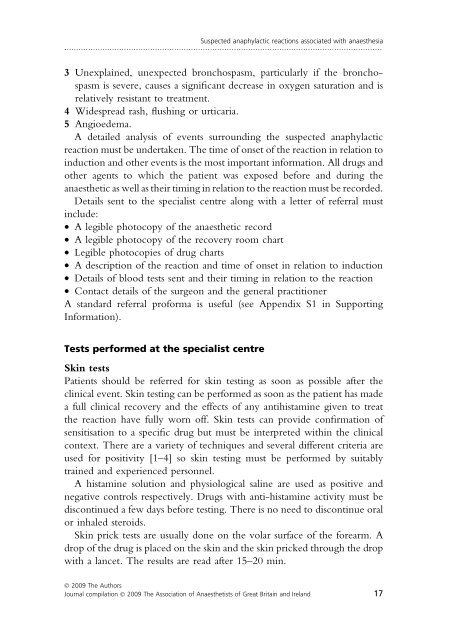Suspected anaphylactic reactions associated with anaesthesia - aagbi
Suspected anaphylactic reactions associated with anaesthesia - aagbi
Suspected anaphylactic reactions associated with anaesthesia - aagbi
- No tags were found...
Create successful ePaper yourself
Turn your PDF publications into a flip-book with our unique Google optimized e-Paper software.
<strong>Suspected</strong> <strong>anaphylactic</strong> <strong>reactions</strong> <strong>associated</strong> <strong>with</strong> <strong>anaesthesia</strong>.....................................................................................................................................3 Unexplained, unexpected bronchospasm, particularly if the bronchospasmis severe, causes a significant decrease in oxygen saturation and isrelatively resistant to treatment.4 Widespread rash, flushing or urticaria.5 Angioedema.A detailed analysis of events surrounding the suspected <strong>anaphylactic</strong>reaction must be undertaken. The time of onset of the reaction in relation toinduction and other events is the most important information. All drugs andother agents to which the patient was exposed before and during theanaesthetic as well as their timing in relation to the reaction must be recorded.Details sent to the specialist centre along <strong>with</strong> a letter of referral mustinclude:• A legible photocopy of the anaesthetic record• A legible photocopy of the recovery room chart• Legible photocopies of drug charts• A description of the reaction and time of onset in relation to induction• Details of blood tests sent and their timing in relation to the reaction• Contact details of the surgeon and the general practitionerA standard referral proforma is useful (see Appendix S1 in SupportingInformation).Tests performed at the specialist centreSkin testsPatients should be referred for skin testing as soon as possible after theclinical event. Skin testing can be performed as soon as the patient has madea full clinical recovery and the effects of any antihistamine given to treatthe reaction have fully worn off. Skin tests can provide confirmation ofsensitisation to a specific drug but must be interpreted <strong>with</strong>in the clinicalcontext. There are a variety of techniques and several different criteria areused for positivity [1–4] so skin testing must be performed by suitablytrained and experienced personnel.A histamine solution and physiological saline are used as positive andnegative controls respectively. Drugs <strong>with</strong> anti-histamine activity must bediscontinued a few days before testing. There is no need to discontinue oralor inhaled steroids.Skin prick tests are usually done on the volar surface of the forearm. Adrop of the drug is placed on the skin and the skin pricked through the drop<strong>with</strong> a lancet. The results are read after 15–20 min.Ó 2009 The AuthorsJournal compilation Ó 2009 The Association of Anaesthetists of Great Britain and Ireland 17

















